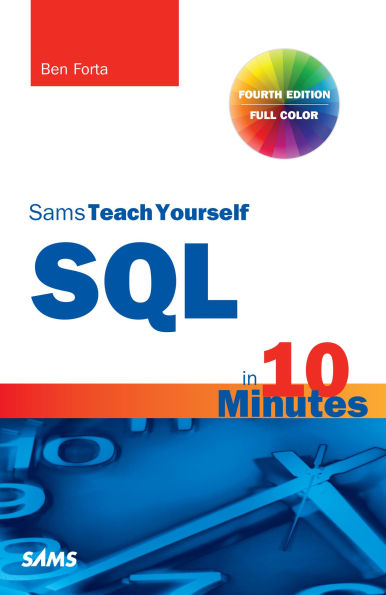Sams Teach Yourself SQL in 10 Minutes, Fourth Edition
New full-color code examples help you see how SQL statements are structured
Whether you're an application developer, database administrator, web application designer, mobile app developer, or Microsoft Office users, a good working knowledge of SQL is an important part of interacting with databases. And Sams Teach Yourself SQL in 10 Minutes offers the straightforward, practical answers you need to help you do your job.
Expert trainer and popular author Ben Forta teaches you just the parts of SQL you need to know–starting with simple data retrieval and quickly going on to more complex topics including the use of joins, subqueries, stored procedures, cursors, triggers, and table constraints.
You'll learn methodically, systematically, and simply–in 22 short, quick lessons that will each take only 10 minutes or less to complete.
With the Fourth Edition of this worldwide bestseller, the book has been thoroughly updated, expanded, and improved. Lessons now cover the latest versions of IBM DB2, Microsoft Access, Microsoft SQL Server, MySQL, Oracle, PostgreSQL, SQLite, MariaDB, and Apache Open Office Base. And new full-color SQL code listings help the beginner clearly see the elements and structure of the language.
10 minutes is all you need to learn how to...
- Use the major SQL statements
- Construct complex SQL statements using multiple clauses and operators
- Retrieve, sort, and format database contents
- Pinpoint the data you need using a variety of filtering techniques
- Use aggregate functions to summarize data
- Join two or more related tables
- Insert, update, and delete data
- Create and alter database tables
- Work with views, stored procedures, and more
1 Understanding SQL
2 Retrieving Data
4 Filtering Data
5 Advanced Data Filtering
6 Using Wildcard Filtering
7 Creating Calculated Fields
8 Using Data Manipulation Functions
9 Summarizing Data
10 Grouping Data
11 Working with Subqueries
12 Joining Tables
13 Creating Advanced Joins
14 Combining Queries
15 Inserting Data
16 Updating and Deleting Data
17 Creating and Manipulating Tables
18 Using Views
19 Working with Stored Procedures
20 Managing Transaction Processing
21 Using Cursors
22 Understanding Advanced SQL Features
Appendix A: Sample Table Scripts
Appendix B: Working in Popular Applications
Appendix C : SQL Statement Syntax
Appendix E: SQL Reserved Words
Sams Teach Yourself SQL in 10 Minutes, Fourth Edition
New full-color code examples help you see how SQL statements are structured
Whether you're an application developer, database administrator, web application designer, mobile app developer, or Microsoft Office users, a good working knowledge of SQL is an important part of interacting with databases. And Sams Teach Yourself SQL in 10 Minutes offers the straightforward, practical answers you need to help you do your job.
Expert trainer and popular author Ben Forta teaches you just the parts of SQL you need to know–starting with simple data retrieval and quickly going on to more complex topics including the use of joins, subqueries, stored procedures, cursors, triggers, and table constraints.
You'll learn methodically, systematically, and simply–in 22 short, quick lessons that will each take only 10 minutes or less to complete.
With the Fourth Edition of this worldwide bestseller, the book has been thoroughly updated, expanded, and improved. Lessons now cover the latest versions of IBM DB2, Microsoft Access, Microsoft SQL Server, MySQL, Oracle, PostgreSQL, SQLite, MariaDB, and Apache Open Office Base. And new full-color SQL code listings help the beginner clearly see the elements and structure of the language.
10 minutes is all you need to learn how to...
- Use the major SQL statements
- Construct complex SQL statements using multiple clauses and operators
- Retrieve, sort, and format database contents
- Pinpoint the data you need using a variety of filtering techniques
- Use aggregate functions to summarize data
- Join two or more related tables
- Insert, update, and delete data
- Create and alter database tables
- Work with views, stored procedures, and more
1 Understanding SQL
2 Retrieving Data
4 Filtering Data
5 Advanced Data Filtering
6 Using Wildcard Filtering
7 Creating Calculated Fields
8 Using Data Manipulation Functions
9 Summarizing Data
10 Grouping Data
11 Working with Subqueries
12 Joining Tables
13 Creating Advanced Joins
14 Combining Queries
15 Inserting Data
16 Updating and Deleting Data
17 Creating and Manipulating Tables
18 Using Views
19 Working with Stored Procedures
20 Managing Transaction Processing
21 Using Cursors
22 Understanding Advanced SQL Features
Appendix A: Sample Table Scripts
Appendix B: Working in Popular Applications
Appendix C : SQL Statement Syntax
Appendix E: SQL Reserved Words

SQL in 10 Minutes, Sams Teach Yourself
288
SQL in 10 Minutes, Sams Teach Yourself
288
Product Details
| ISBN-13: | 9780133048087 |
|---|---|
| Publisher: | Pearson Education |
| Publication date: | 10/25/2012 |
| Series: | Sams Teach Yourself |
| Sold by: | Barnes & Noble |
| Format: | eBook |
| Pages: | 288 |
| File size: | 10 MB |
| Age Range: | 18 Years |
